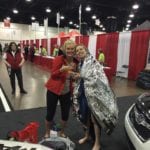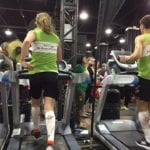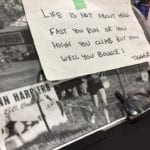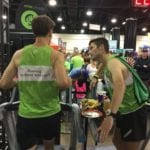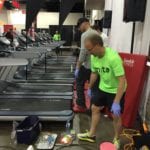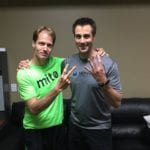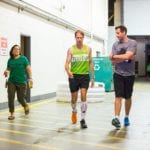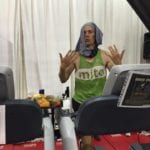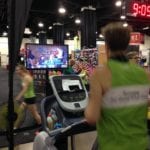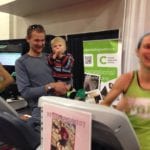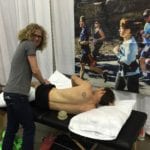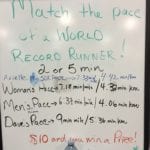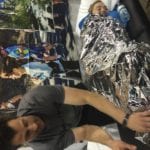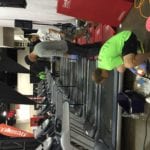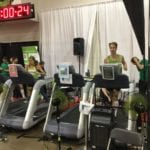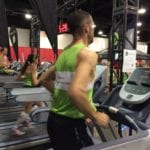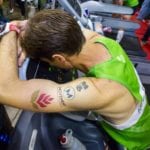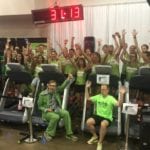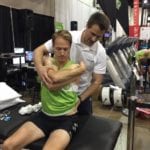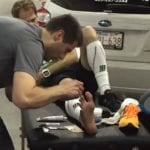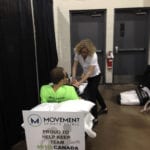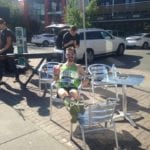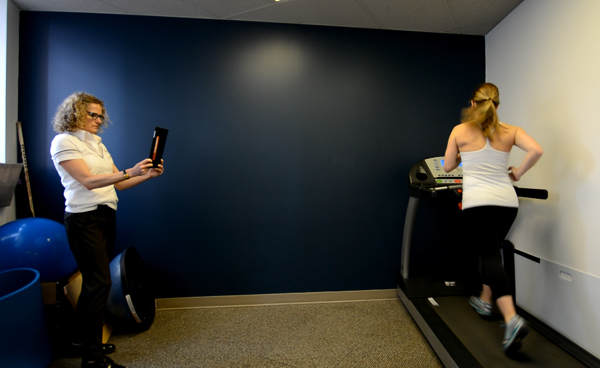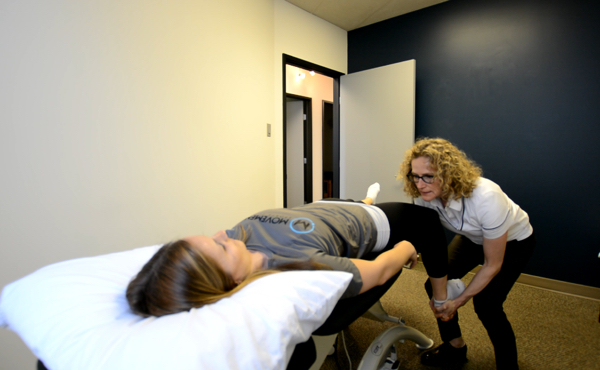Event details, photos, videos and more!
Movement Sports Clinic therapists were proud to provide support to the Team Mito Canada runners over their 24-hour quest at the Calgary Marathon Expo for six Guinness World treadmill records. The event occurred from 4pm on May 28 to 4pm on May 29th, 2016 at the Calgary Marathon Expo.
Solo runner Dave Proctor set two new world records for most kilometers run on a treadmill in 12 hours (139.22 km) and 24 hours (260.4 km). Solo runner Arielle Fitzgerald beat the 50km record (3:51) and set the 100km record (8:30:34) on a treadmill. Female and male teams of 12 runners also set new world records for cumulative distance run on a treadmill over 24 hours. The team runners ran four sets of 30 minutes each over the 24-hour timeframe, and they ran hard. The team runners frequently had the treadmills at maximum speed capacity of 20 km/h. The men’s team ended up running 394.76 kilometers and the women’s team ran 344.45 kilometers to both establish new Guinness World treadmill records.
MitoCanada is a charitable organization founded by local runner Blaine Penny and his family in support of mitochondrial disease research and awareness. This inherited disorder affects the energy production of our cells and leads to developmental, movement and cognitive disability. Blaine’s son has the disorder and local runners have rallied in fundraising efforts over the last several years. The Guinness World event raised over $75,000. To learn more about MitoCanada or to make a donation, please check out www.mitocanada.org
As testament to the resilience, durability and dedication to MitoCanada and running, several of the athletes competed in the Calgary Marathon running events the next day. Calum Neff and Blaine Penny came second and fifth, respectively in the 50km ultra race. Adriana Wild and Debbie Reed came 2nd and 3rd respectively in the 50km race. Keith Bradford won his age group in the half-marathon. Greg Medwid ran the 50km and lounged part way to have a Jugo Juice smoothie! And a number of the other TeamMito runners in their green shirts were spotted around the race course.
Special mentions go out to Ultra Master of Ceremonies, Daniel Bowie and Ultra Project Manager Robert Lazorko. Other than Dave, Daniel was the only person to be at the event the full 24 hours +. Daniel’s wit, motivation and cool lime green suit kept things lively for everyone at the event. Daniel, an offer stands for a complimentary jaw massage is still available for you anytime! Robert kept everything running smoothly and was willing to get down and dirty cleaning treadmills, filling ice baths and answering pretty much any question and finding a solution. Robert also ran the 50km the next day.
Tyson Plesuk has been the physiotherapist for 24-hour solo runner, Dave Proctor for the last six years and was on hand to provide both moral and physiotherapy support. Louise Taylor has been working with 50k and 100k solo runner, Arielle Fitzgerald, over the last couple of months, and was also present to provide assistance.
Fortunately, the musculoskeletal issues were limited to blister control and managing muscle tightness. Predictably the mental side of such an event was the biggest challenge. The solo runners also had gastrointestinal distress, headaches and lightheadedness to add to the challenge. Dave Proctor even had enough energy at 2:50am to Whip Nay Naying on a treadmill after running over 10hrs and 115km!
Tyson and Louise were kept busy working with the team runners through their running rotations over the 24-hour period. Groups of four runners would be on-site for four hours at a time running at high intensity twice for 30 minutes. They would then return several hours again to repeat. Most of the issues that Movement Sports Clinic’s therapists treated were related to muscle tightness, inhibition and soft tissue fatigue. Muscle release techniques, stretching and muscle activation were the most common therapies provided by Movement Sports Clinic’s therapists on minimal sleep.
Louise Taylor said, “Dave Proctor and Arielle Fitzgerald showed me the real meaning of endurance and what digging to the depths of their souls looks like. Unforgettable!”
Tyson Plesuk said, “What an amazing and special 24 hours that all the runners created to raise awareness and money for MitoCanada. The energy and atmosphere were electric each time one of the six Guinness World Records was broken. And Dave and Arielle demonstrated such an amazing display of pure heart and determination to push their bodies to the limits. This was an experience I will never forget!”
It was a pleasure to work with these dedicated, strong and elite athletes in their support of such a great cause. The team at Movement Sports Clinic salutes their effort!
Solo Runners:
Dave Proctor & Arielle Fitzgerald
Women’s team: Allison Blackmore, Shannyn Clancy, Devon Karchut, Carmen Lambert, Megan MacDonald, Jen MacPherson, Melissa Paauwe (captain), Debbie Reed, Faye Stenning, Sharon Styles, Adriana Wild, Arden Young
Men’s team: Darcy Bell, Keith Bradford, Adam Campbell, Jody Draude, Adam Kahtava, Tristan Janusc (captain), Rich MacDonald, Duncan Marsden, Greg Medwid, Calum Neff, Myron Tetreault, Blaine Penny
- Arielle and Tori after the event
- Arielle Fitzgerald and Dave Proctor
- Arielle Fitzgerald’s Motivation!
- Blaine Penny and Dave Proctor – two super heros inspiring each other
- Clean Up
- Dave Proctor and Tyson Plesuk after Dave broke 2 Guinness World Records
- Dave Proctor and Tyson Plesuk during the 24HRS
- Dave trying to stay cool 7 hours in
- Dave watching Wayne’s World
- Devon Karchut gets a visit from Paul Karchut and Roger
- Louise Taylor and Arielle Fitzgerald embrace after Arielle broke 2 Guinness World Records
- Louise Taylor providing manual therapy during the event
- Match the pace challenge!
- Post event warm up for Arielle
- Project Manager Robert – event clean up
- Runners 14 HRs in!
- Solo Dave Proctor, Women’s team Devon Karchut and Men’s team Greg Medwid
- Solo Runner – Dave Proctor, Women’s team – Melissa Paauwe and Men’s Team – Cal Neff
- Solo runner Dave Proctor
- Team Mito Canada!
- Tyson Plesuk getting Dave geared up for his 24HRs
- Tyson Dealing with Dave’s Blister
- Greg Medwid lounging with a Jugo Juice mid Calgary marathon!



